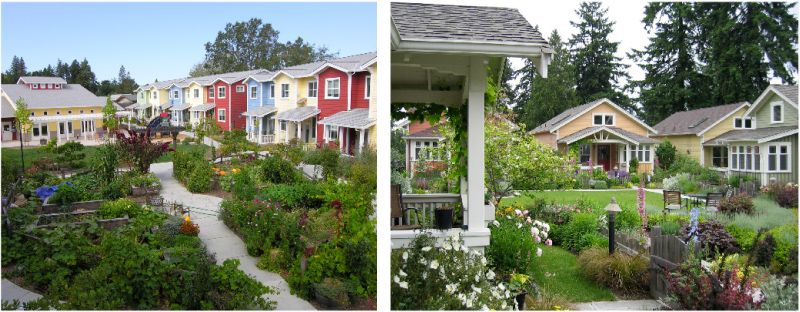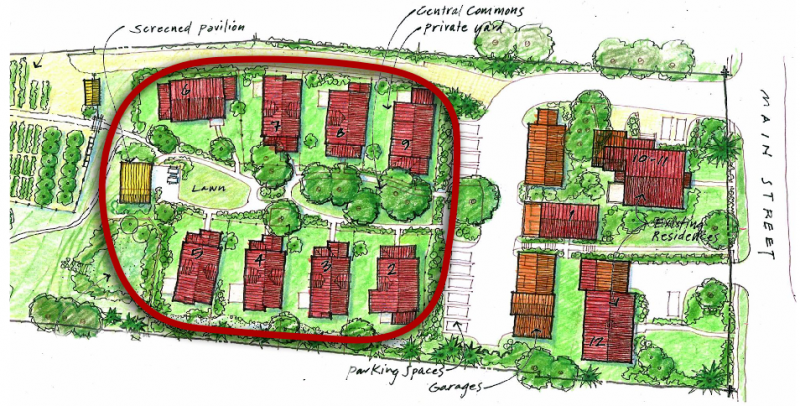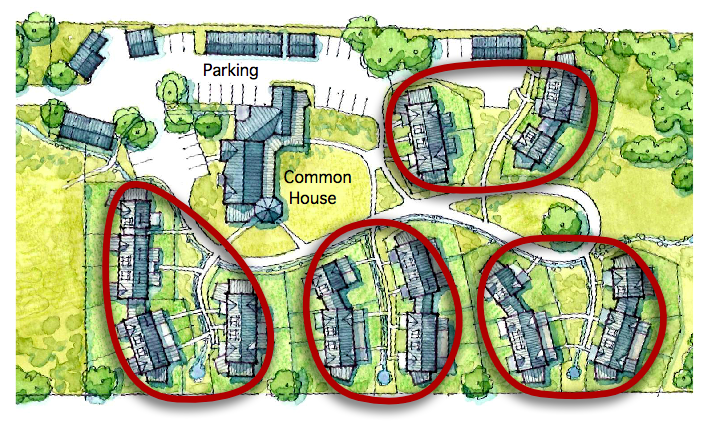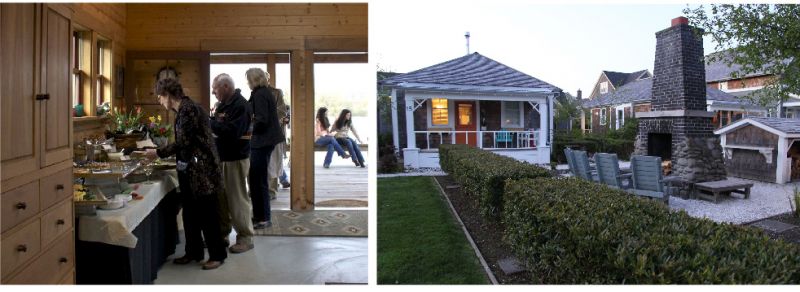
Cohousing communities are intentional by nature, with residents purposely coming together around shared values and commitments. In Pocket Neighborhoods, a sense of community may arise naturally among neighbors by the fact of living around a commons, and may be augmented with more intention.
(left: Petaluma Avenue Cohousing /photo by Grace Kim; right: Greenwood Avenue Cottages /photo by Karen DeLucas)
Cohousing has been taking hold across North America and around the world, offering an enticing option for people wanting to live in a more closely knit community. Some even call it a movement. Pocket Neighborhoods are being tossed around as a viable housing approach within existing neighborhoods, as well as sub-neighborhoods within larger new developments. Both foster a sense of community by design; but what’s the difference between the two?
Pocket neighborhoods, by our definition, are clusters of nearby neighbors around a shared commons of some sort — micro-neighborhoods with a scale of sociability. They are the physical arrangements of houses or apartments, or even trailers, designed to foster neighborly interactions while preserving personal privacy. A sense of community may arise naturally (more or less) among its residents by the fact that everyone lives around a commons.
In cohousing, community is intentional. Future residents purposely come together around clearly defined shared values and visions, and then plan and build the physical environment*, and manage the community once it is built. Residents are expected to take part in regular team-cooked meals, be on committees and engage in shared responsibilities. Decisions and disputes are handled as much as possible through consensus. Social life of the residents is often centered among members of the community.

A classic cottage courtyard pocket neighborhood tucked behind two existing houses on a town street.
All during the research and writing of my book, I asked, ‘what is the right size of a pocket neighborhood?’ I was aware that cohousing communities typically have 20–30 households, a number that advocates believe to be optimum – large enough to have a diversity of residents and social coherence, yet not too large where decision-making becomes cumbersome. My sense was that pocket neighborhoods were smaller – with 6–10 households (more or less), which is a natural scale of sociability among humans. These are one’s closest neighbors who relate informally during the comings and goings of daily activity. Then I recognized that most (but not all) cohousing communities are configured with a series of pocket neighborhood-like clusters. The larger community is an aggregate of smaller subgroups. My hunch is that this was design by common sense, rather than an intentional social configuration.

Pocket Neighborhood clusters within a cohousing community.
Pocket neighborhoods that were not originally organized as cohousing communities sometimes become more cohousing-like by instigating regular shared meals, garden work parties, social events, and decision-making and dispute resolution practices.
Cohousing, with it’s larger size and it’s emphasis on community, will usually have a large (3000–5000 SF) common house with a commercial kitchen, community dining room, living room, guest rooms, children’s playrooms, workshop, exercise gym, and more.
Cohousing common houses have extensive spaces and amenities to serve the community.
(Common House at Nevada City Cohousing)
Pocket neighborhoods initiated by developers tend to have modest community facilities, but they have at least a place where nearby neighbors can come together – such as a picnic shelter or open-air barbecue. If budgets allow, they may have a four-season community room with a kitchen and bathroom, and perhaps a guest room. They almost always have a shared toolshed.

Pocket neighborhoods have more modest common gathering spaces, such as a community room or outdoor fireplace. (left: Salish Pond Cottages; right: Seabrook)
Whether a pocket neighborhood stands on its own, or is a sub-cluster of a larger cohousing community, the social size of the cluster is what they are about. Of course, other patterns factor in to their design, but their essential ingredient is the particular scale at which neighborly relations tend to blossom.
Hope this helps. Please chime in with your perspective and experience.
—Ross Chapin
*post script: the US Cohousing Association recently updated their definition of cohousing, loosening the requirement that residents be involved in planning their communities to use the term “cohousing”. A common house is not a requirement either, though there is an expectation to have ample common amenities.


Building more pocket subdivisions is definitely quite the uphill battle because zoning, financing, and house construction companies are nearly exclusively geared towards the large suburban houses. Large suburban single-family homes are great for traditional growing families and those who value a very generous amount of space and love driving everywhere, but terrible for people who can’t drive or don’t want to drive all the time. And don’t get me started on the unaffordable price tags of conventional housing, it’s usually either pay $1800+ per month in mortgage and $2000+ on insurance and property taxes, or pay $2300+ a month to rent an apartment in a large complex with amenities you rarely if ever have the time to actually enjoy as you’re working 8-10 hour days 5 or 6 days a week to pay the bills. If you’re really that much of a social butterfly and \or workaholic (out of choice), you really only need your home to be a place to sleep, change clothes, take showers and possibly cook some light meals, in this case, all you really need in a dwelling is a bedroom, bathroom and kitchenette.
Hello,
I am actually reaching out for my brother. He is interested in getting valid information, regarding Cohousing communities and/and or communal type housing. My brother is 70 yrs. old, lives on Long Island, New York, which is extremely expensive and has become much too crowed for him. He was a landscaper for many years, studied organic garden, principles, etc. before injuring his back. He is an artist, his specialty being land and seascapes.
He is looking for a small apartment or studio, where he can co-exist with like-minded individuals. He realizes he will have to move out of New York because of the inflated rental prices.
We’ve been researching, but… have yet to find communities that offer studios or one bdrm. apartments for sale, preferably, for rent.
While researching, I came upon your name and work and I am hoping you can give my brother direction, in terms of websites, etc., that will provide valid information, in terms of if and where these communities exist and costs involved.
Thanks very much.
The first place we suggest is http://www.cohousing.org. It’s a terrific resource, including regional and topic groups to look into. Good luck!
While the cost of construction is high in many regions, discussing the construction of 8-10 cottages with a contractor will be different than discussing one cottage. A million plus contract would have to be more inviting and productive. There is also the modular housing market to consider. Most will do custom designs of there stock buildings with interior and exterior contracted out by the owner.
Beyond the cost of the building, the cost of land can be as or more critical. My wife and ran a B&B for about 10 years (typical time span). We now live in a 3000 square foot, six bedroom, six bathroom house on three acres of beautifully landscaped property overlooking the Northumberland Strait of New Brunswick. Needless to say, we only use about 1/3 of the house. In the current housing market on the coast of New Brunswick, we would be lucky to get $300,000 if we sold the property. Ten households could purchase the property together and in common at a cost of $30,000 each while just a typical one acre lot cost $50,000 or more. They would acquire a full landscaped established 3 acre property with a 3000 square foot common house already built. Looking for B&B closures as a core for pocket neighborhoods seems logical.
While there may be a few example I have yet to see a co housing community with front facing garage doors. Most cluster parking or use a rear alley.
Thanks for the shout out, Ross.
One key distinction that is not emphasized here is scale: pocket neighborhoods are intentionally smaller scaled in all ways — smaller homes, smaller yards, smaller footprints. This closeness also requires careful planning. I appreciate that in his designs Ross is careful to have alternating window walls. The separation of living and vehicles is also key. Co-housing typically will still have drives and front-facing garages.
To me, the differentiators for pocket neighborhoods is what makes them so attractive.
But while they have been on my ‘wish list’ for a really long time, the reality it a bit of a struggle. Very few developers or builders are willing to discuss these types of projects. Leaving those of us who want to live in them to start looking at becoming small-scale developers. As well, those of us who were among the ’99ers’ (99 weeks collecting unemployment), whose careers have never recovered, even a pocket neighborhood home with a common house may be out of our reach. As I’ve been looking to price out projects, I’ve found that I may need to first look at cottage clusters, retaining all the common elements that make pocket neighborhoods great but without the added costs of the common house. I’m looking at some ways to still create common gathering spaces, maybe by combining it with the covered parking and/or storage.
There are still a lot of people who at one time even had beautiful 3 car garage homes who can barely afford rent for a 1-bedroom apartment who would love to own their own home again. And not just 4 walls, but very well designed interiors. The production builders are all missing the need for this type of housing.
Paula, the smaller scale of homes and yards is sometimes the case in pocket neighborhoods, but that’s not an essential. Pocket neighborhoods can have larger detached homes, or they may be clusters of micro-apartments. As I write in the post, the most important factor is the scale of sociability.
When we design houses and neighborhoods, we pay attention to adjacencies and layering almost to a fault. Real people will live there! Living in closer proximity can be a better experience with sensitive design. We’re trying to name the essential ‘design bones’ so other designers and developers can do a better job.
Regarding the affordability issue – this is one of the major challenges of our time. We don’t have THE answer, but we’re trying to edge into possible solutions. Our Fifth Street Commons neighborhood is one effort. A longer blog post on the issue is warranted.
I applaud your effort at considering becoming a small-scale developer yourself. It can be challenging, but if you have the sensibility and tenacity for this, it would be well worth the effort. And you would be creating something really needed in your community. Check out John Anderson’s blog – he’s mentoring rookie developers on the nuts & bolts of small-scale projects.
Paula Thornton, the separation of living and vehicles is also key to cohousing. “Pedestrian-oriented design with the cars at the periphery” is an important factor where spontaneous social interaction and safety are paramount to cohousing communities. If you can find a site plan of a typical cohousing community with drives and front-facing garages I would appreciate knowing about it.
Also, because most people who are attracted to cohousing and the sharing of amenities, tools, and toys, are interested in lessening their ecological footprint, the homes in most cohousing communities tend to be substantially smaller than market housing in their area. It is not uncommon for sizes to range from 600 – 1200 square feet for studio to 3 bedroom homes.
A pocket neighborhood can consist of almost any format of dwelling unit, detached cabins or cottages, semi-detached homes\duplexes, small rowhouses, apartments, etc. All of these dwelling formats come with advantages and disadvantages. The main benefit of apartments is how efficient the buildings are, whereas the main benefit of detached homes is the greater space and more privacy, though in a pocket subdivision the houses are still small than those in most suburban American areas.